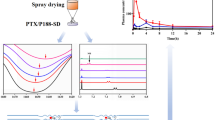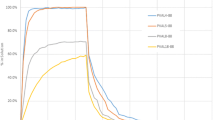Abstract
The aim of the present investigation was to evaluate the effect of supersaturation on the oral absorption of paclitaxel (PTX) in vivo. To achieve this, a PTX amorphous solid dispersion (ASD) was prepared by the solvent cast method. Among the enteric polymers tested, hypromellose acetate succinate (HPMCAS) MF was found to be the most suitable polymer for maintaining PTX supersaturation and inhibiting crystallization in vitro. The dissolution rate and extent of the ASD was remarkably improved compared with a physical mixture (PM) of PTX, HPMCAS-MF, and Poloxamer 188 (F68), reaching an apparent drug concentration of 25–30 μg/mL and maintaining it for more than 2 h. The liquid–liquid phase separation (LLPS) concentration of PTX in the presence of HPMCAS-MF was determined to be 23 μg/mL, which was different to that of 40 μg/mL in the absence of polymer. It indicated that HPMCAS was substantially incorporated into the drug-rich phase. Also, HPMCAS could absorb to the PTX surface and provided an interfacial barrier for crystal growth, as well as retard the incorporation of PTX from solution into the growing crystal lattice. The results of X-ray diffraction, differential scanning calorimetry analysis, and transmission electron microscopy confirmed that PTX existed in the amorphous state in the solid dispersion. Compared with the PM group, the ASD prepared with HPMCAS-MF and F68 achieved a 1.78-fold increase in relative oral bioavailability, while PTX solution yielded a 1.56-fold increase, which could be explained that the solubility and the permeability of PTX were not increased simultaneously through supersaturation in vivo. Likely, it was because Cremophor inhibited P-glycoprotein in the intestine to some extent and maintained PTX at a higher concentration for a longer time.









Similar content being viewed by others
References
Batlle JF, et al. Oral chemotherapy: potential benefits and limitations. Rev Oncol. 2004;6(6):335–40.
Rao VM, Stella VJ. When can cyclodextrins be considered for solubilization purposes? J Pharm Sci. 2003;92(5):927–32.
Dahan A, Beig A, Lindley D, Miller JM. The solubility-permeability interplay and oral drug formulation design: two heads are better than one. Adv Drug Deliv Rev. 2016;101:99–107.
Dahan A, Miller JM. The solubility-permeability interplay and its implications in formulation design and development for poorly soluble drugs. Aaps J. 2012;14(2):244–51.
Green MC, Buzdar AU, Smith T, Ibrahim NK, Valero V, Rosales MF, et al. Weekly paclitaxel improves pathologic complete remission in operable breast cancer when compared with paclitaxel once every 3 weeks. J Clin Oncol Off J Am Soc Clin Oncol. 2005;23(25):5983–92.
Rowinsky EK, et al. Taxol: the first of the taxanes, an important new class of antitumor agents. Semin Oncol. 1992;19(6):646.
Brouwers J, Brewster ME, Augustijns P. Supersaturating drug delivery systems: the answer to solubility-limited oral bioavailability? J Pharm Sci. 2009;98(8):2549–72.
Mo R, Jin X, Li N, Ju C, Sun M, Zhang C, et al. The mechanism of enhancement on oral absorption of paclitaxel by N-octyl-O-sulfate chitosan micelles. Biomaterials. 2011;32(20):4609–20.
Feng SS, Zhao L, Zhang Z, Bhakta G, Yin Win K, Dong Y, et al. Chemotherapeutic engineering: vitamin E TPGS-emulsified nanoparticles of biodegradable polymers realized sustainable paclitaxel chemotherapy for 168h in vivo. Chem Eng Sci. 2007;62(23):6641–8.
Wang XX, et al. The antitumor efficacy of functional paclitaxel nanomicelles in treating resistant breast cancers by oral delivery. Biomaterials. 2011;32(12):3285.
Lv PP, Wei W, Yue H, Yang TY, Wang LY, Ma GH. Porous quaternized chitosan nanoparticles containing paclitaxel nanocrystals improved therapeutic efficacy in non-small-cell lung cancer after oral administration. Biomacromolecules. 2011;12(12):4230–9.
Liu F, Park JY, Zhang Y, Conwell C, Liu Y, Bathula SR, et al. Targeted cancer therapy with novel high drug-loading nanocrystals. J Pharm Sci. 2010;99(8):3542–51.
Lee E, Lee J, Lee IH, Yu M, Kim H, Chae SY, et al. Conjugated chitosan as a novel platform for oral delivery of paclitaxel. J Med Chem. 2008;51(20):6442–9.
Jain S, Kumar D, Swarnakar NK, Thanki K. Polyelectrolyte stabilized multilayered liposomes for oral delivery of paclitaxel. Biomaterials. 2012;33(28):6758–68.
Mazzaferro S, Bouchemal K, Ponchel G. Oral delivery of anticancer drugs I: general considerations. Drug Discov Today. 2013;18(1–2):25–34.
Roger E, Lagarce F, Garcion E, Benoit JP. Lipid nanocarriers improve paclitaxel transport throughout human intestinal epithelial cells by using vesicle-mediated transcytosis. J Control Release. 2009;140(2):174–81.
Batrakova EV, Han HY, Alakhov VY, Miller DW, Kabanov AV. Effects of pluronic block copolymers on drug absorption in Caco-2 cell monolayers. Pharm Res. 1998;15(6):850–5.
Sue May L, et al. Enhancement of docetaxel solubility using binary and ternary solid dispersion systems. Drug Dev Ind Pharm. 2015;41(11):1.
Warren DB, Benameur H, Porter CJH, Pouton CW. Using polymeric precipitation inhibitors to improve the absorption of poorly water-soluble drugs: a mechanistic basis for utility. J Drug Target. 2010;18(10):704–31.
Seeballuck F, Ashford MB, O'Driscoll CM. The effects of pluronics block copolymers and Cremophor EL on intestinal lipoprotein processing and the potential link with P-glycoprotein in Caco-2 cells. Pharm Res. 2003;20(7):1085–92.
Curatolo W, Nightingale JA, Herbig SM. Utility of hydroxypropylmethylcellulose acetate succinate (HPMCAS) for initiation and maintenance of drug Supersaturation in the GI milieu. Pharm Res. 2009;26(6):1419–31.
Sawicki E, Schellens JHM, Beijnen JH, Nuijen B. Inventory of oral anticancer agents: pharmaceutical formulation aspects with focus on the solid dispersion technique. Cancer Treat Rev. 2016;50:247–63.
Amidon GL, Lennernäs H, Shah VP, Crison JR. A theoretical basis for a biopharmaceutic drug classification: the correlation of in vitro drug product dissolution and in vivo bioavailability. Pharm Res. 1995;12(3):413–20.
Rabizzoni P. Development of a rebamipide solid dispersion system with improved dissolution and oral bioavailability. Arch Pharm Res. 2015;38(4):522.
Shuai S, Yue S, Huang Q, Wang W, Yang J, Lan K, et al. Preparation, characterization and in vitro/vivo evaluation of tectorigenin solid dispersion with improved dissolution and bioavailability. Eur J Drug Metab Pharmacokinet. 2016;41(4):413–22.
Miller JM, Beig A, Carr RA, Spence JK, Dahan A. A win-win solution in oral delivery of lipophilic drugs: supersaturation via amorphous solid dispersions increases apparent solubility without sacrifice of intestinal membrane permeability. Mol Pharm. 2012;9(7):2009–16.
Beig A, Fine-Shamir N, Lindley D, Miller JM, Dahan A. Advantageous solubility-permeability interplay when using amorphous solid dispersion (ASD) formulation for the BCS class IV P-gp substrate Rifaximin: simultaneous increase of both the solubility and the permeability. Aaps J. 2017;19(3):806–13.
Blandizzi C, Viscomi GC, Scarpignato C. Impact of crystal polymorphism on the systemic bioavailability of rifaximin, an antibiotic acting locally in the gastrointestinal tract, in healthy volunteers. Drug Des Devel Ther. 2014;9:1–11.
Walle UK, Walle T. Taxol transport by human intestinal epithelial Caco-2 cells. Drug Metab Dispos. 1998;26(4):343.
Sandström M, et al. The pharmacokinetics of epirubicin and docetaxel in combination in rats. Cancer Chemother Pharmacol. 1999;44(6):469–74.
Peltier S, Oger JM, Lagarce F, Couet W, Benoît JP. Enhanced oral paclitaxel bioavailability after administration of paclitaxel-loaded lipid nanocapsules. Pharm Res. 2006;23(6):1243–50.
Artursson P. Coexistence of passive and carrier-mediated processes in drug transport. Nat Rev Drug Discov. 2010;9(8):597–614.
Abuasal BS, Bolger MB, Walker DK, Kaddoumi A. In silico modeling for the nonlinear absorption kinetics of UK-343,664: a P-gp and CYP3A4 substrate. Mol Pharm. 2012;9(3):492–504.
Cisternino S, Bourasset F, Archimbaud Y, Sémiond D, Sanderink G, Scherrmann JM. Nonlinear accumulation in the brain of the new taxoid TXD258 following saturation of P-glycoprotein at the blood-brain barrier in mice and rats. Br J Pharmacol. 2003;138(7):1367–75.
Varma MVS, Khandavilli Sateesh A, Panchagnula R. Functional role of P-glycoprotein in limiting intestinal absorption of drugs: contribution of passive permeability to P-glycoprotein mediated efflux transport. Mol Pharm. 2005;2(1):12–21.
Moes J, Koolen S, Huitema A, Schellens J, Beijnen J, Nuijen B. Development of an oral solid dispersion formulation for use in low-dose metronomic chemotherapy of paclitaxel. Eur J PharmBiopharm. 2013;83(1):87–94.
Huizing MT, Rosing H, Koopman F, Keung ACF, Pinedo HM, Beijnen JH. High-performance liquid chromatographic procedures for the quantitative determination of paclitaxel (Taxol) in human urine. J Chromatogr B Biomed Appl. 1995;664(2):373–82.
Piao H, et al. A pre-formulation study of a polymeric solid dispersion of paclitaxel prepared using a quasi-emulsion solvent diffusion method to improve the oral bioavailability in rats. Drug Dev Ind Pharm. 2016;42(3):1–11.
Ilevbare GA, Taylor LS. Liquid–liquid phase separation in highly supersaturated aqueous solutions of poorly water-soluble drugs: implications for solubility enhancing formulations. Cryst Growth Des. 2013;13(4):1497–509.
Jackson MJ, Toth SJ, Kestur US, Huang J, Qian F, Hussain MA, et al. Impact of polymers on the precipitation behavior of highly supersaturated aqueous danazol solutions. Mol Pharm. 2014;11(9):3027–38.
Chen Y, et al. Sodium lauryl sulphate competitively interacts with HPMC-AS and consequently reduces oral bioavailability of posaconazole/HPMC-AS amorphous solid dispersion. Mol Pharm. 2016;13(8)
Ueda K, Higashi K, Moribe K. Direct NMR monitoring of phase separation behavior of highly supersaturated Nifedipine solution stabilized with Hypromellose derivatives. Mol Pharm. 2017;14(7):2314–22.
Ilevbare GA, Liu H, Pereira J, Edgar KJ, Taylor LS. Influence of additives on the properties of nanodroplets formed in highly supersaturated aqueous solutions of ritonavir. Mol Pharm. 2013;10(9):3392–403.
Ilevbare GA, et al. Effect of binary additive combinations on solution crystal growth of the poorly water-soluble drug, Ritonavir. Cryst Growth Des. 2017;12(12):6050–60.
Raina SA, Zhang GGZ, Alonzo DE, Wu J, Zhu D, Catron ND, et al. Impact of solubilizing additives on supersaturation and membrane transport of drugs. Pharm Res. 2015;32(10):3350–64.
Sun DD, Lee PI. Evolution of supersaturation of amorphous pharmaceuticals: the effect of rate of supersaturation generation. Mol Pharm. 2013;10(11):4330–46.
Lahav M, Leiserowitz L. The effect of solvent on crystal growth and morphology. Chem Eng Sci. 2001;56(7):2245–53.
Prasad D, Chauhan H, Atef E. Role of molecular interactions for synergistic precipitation inhibition of poorly soluble drug in supersaturated drug-polymer-polymer ternary solution. Mol Pharm. 2016;13(3):756–65.
Puel F, Verdurand E, Taulelle P, Bebon C, Colson D, Klein JP, et al. Crystallization mechanisms of acicular crystals. J Cryst Growth. 2008;310(1):110–5.
Tomaru A, Takeda-Morishita M, Maeda K, Banba H, Takayama K, Kumagai Y, et al. Effects of Cremophor EL on the absorption of orally administered saquinavir and fexofenadine in healthy subjects. Drug Metab Pharmacokinet. 2015;30(3):221–6.
Taylor LS, Zhang GG. Physical chemistry of supersaturated solutions and implications for oral absorption. Adv Drug Deliv Rev. 2016;101:122–42.
Frenkel YV, Clark AD, Das K, Wang YH, Lewi PJ, Janssen PAJ, et al. Concentration and pH dependent aggregation of hydrophobic drug molecules and relevance to oral bioavailability. J Med Chem. 2005;48(6):1974–83.
Indulkar AS, Gao Y, Raina SA, Zhang GGZ, Taylor LS. Exploiting the phenomenon of liquid–liquid phase separation for enhanced and sustained membrane transport of a poorly water-soluble drug. Mol Pharm. 2016;13(6):2059–69.
Funding
This work was supported by the National Basic Research Program of China (973 Program, No. 2015CB932103), National Natural Science Foundation of China (No. 81673378), and China Postdoctoral Science Foundation (2016M600216).
Author information
Authors and Affiliations
Corresponding author
Ethics declarations
Conflict of interest
The authors declare that they have no conflict of interest.
Ethical approval
All institutional and national guidelines for the care and use of laboratory animals were followed.
Rights and permissions
About this article
Cite this article
Miao, L., Liang, Y., Pan, W. et al. Effect of supersaturation on the oral bioavailability of paclitaxel/polymer amorphous solid dispersion. Drug Deliv. and Transl. Res. 9, 344–356 (2019). https://doi.org/10.1007/s13346-018-0582-9
Published:
Issue Date:
DOI: https://doi.org/10.1007/s13346-018-0582-9




